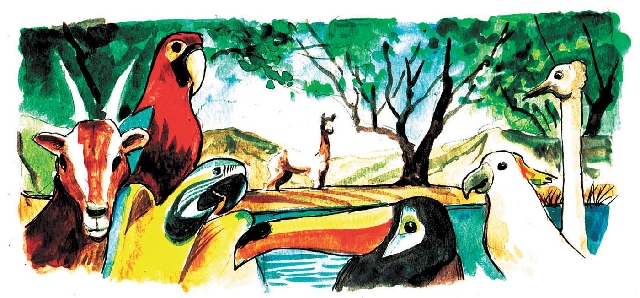Visit feathered, furry friends at Gilcrease sanctuary

Despite the ever-expanding urban development in the Las Vegas Valley, remnants of the area’s rural past live on in a few places such as the Gilcrease Nature Sanctuary, Gilcrease Orchard and the nearby city park at Tule Springs.
The hardworking Gilcrease family developed truck gardens, orchards, a vineyard and pastures on 1,500 acres in the northwest part of the valley in the early decades of the 1900s. Fruits, vegetables, eggs and poultry from the Gilcrease Ranch helped feed early Las Vegans. Although the vineyard did not survive Prohibition, it proved that grapes could thrive in our desert climate.
After an accident claimed the head of the family, his wife maintained the ranch with the help of her two sons. Over time, the acreage of the original ranch has dwindled as the Gilcrease family donated or sold land and the city encroached. Two unique parcels remain: the Gilcrease Nature Sanctuary and the Gilcrease Orchard.
At the nature sanctuary he founded in 1970, Bill Gilcrease pursued his lifelong interest in animals. Now in his 90s and the sole survivor of the family, Gilcrease still watches over the sanctuary, but he leaves the arduous work of caring for the animals to others.
The pick-your-own-fruit orchard with adjacent truck gardens was the pet project of the other Gilcrease son, Ted. Although they share a common history, the two multiacre parcels are separate entities, each run by its own board of directors.
The nature sanctuary is located at 8103 Racel St. To reach it, drive north on U.S. Highway 95 past the Las Vegas Beltway. Exit U.S. 95 at Durango Drive, turning right to go north. Continue through the light at Grand Teton Drive. Watch for the right turn at Racel, a couple of blocks north of Grand Teton. The parking lot is on a side street to the right of Racel, near the entrance to the sanctuary.
The Gilcrease sanctuary is open daily from 9 a.m. to 4 p.m. The entrance fee is $5 for adults, $4 for military members and seniors and $1 for children 2 and older. All children must be accompanied by an adult. For more information, call 645-4224.
Near a rock-bordered fish pond at the entrance, various pathways fan out onto the grounds. Visitors are free to explore the sanctuary using these paths and small access roads. The sanctuary is home to a wide variety of poultry, farm animals and a few exotic creatures. They are housed in aviaries, corrals, enclosures and in or around ponds. Some birds freely wander the grounds.
Glance inside the administrative building to see a few caged exotic birds that need special care and a small hatchery where bird eggs are incubated. A few hatchlings may be kept there until they are large enough to join the rest of the sanctuary’s bird population.
Visitors may pet many of the animals, including goats, miniature horses, donkeys, llamas and a few cows. Others such as the emus and ostriches are better viewed from the walkway.
There is always activity around the ponds, where ducks, geese and swans share the water.
The nesting birds soon will be caring for babies.
Most of the development ends at an open-air amphitheater built into the slope of a large grassy area, site of programs and special events. A few picnic tables on the grass may be used by visitors. Restrooms are nearby.
The sanctuary still is recovering from a devastating fire in 2010 that killed about 200 birds and other animals. Temporary shelters house many of the exotic birds, including survivors of the fire. Future plans include the construction of several climate-controlled aviaries.
The Gilcrease Nature Sanctuary suffered a serious setback but should remain a home for animals and a delight to visitors for many years to come.
Margo Bartlett Pesek’s column appears on Sundays.












